![]()
![]()
![]()
Use LEFT and RIGHT arrow keys to navigate between flashcards;
Use UP and DOWN arrow keys to flip the card;
H to show hint;
A reads text to speech;
69 Cards in this Set
- Front
- Back
|
What are the two components of the nervous system?
|
Central = brain and spinal cord Peripheral = anything outside the CNS |
|
|
Name for flow from periphery TO CNS? CNS to periphery? |
Afferent Efferent |
|
|
Sensory information including input from sensory organs (eye, nose, ear, and taste buds) as well as input from the skin, muscles, joints, and viscera.
Motor information originates in the CNS and travels to glands, smooth muscle, and skeletal muscle.
Which is afferent? Which is efferent? |
Afferent Efferent |
|
|
What is the term for the organization of neural contacts?
What cells function to support and protect neurons? Difference in processes and ratio? |
Circuits or networks
Glial cells (shorter processes than neurons and outnumber by 10:1) |
|
|
What are the three components of the synapse?
What is the space between these component parts? |
Axon terminal of one cell, the dendrite of the receiving cell, and a glial cell process.
Synaptic cleft |
|
|
Name (2) for cell body of neuron?
What is produced here? |
Soma (perikaryon)
Proteins, hormones, and neurotransmitters |
|
|
What is a Nissl substance? |
ER around the nucleus of the soma that stains intensely blue with Nissl stain |
|
|
How are molecules produced in the soma transported to the peripheral synapses?
What is the term for transport from the perikaryon along the axon to the synapse termed?
Term for transport from synaptic terminal to perikaryon? (critical for neurotrophin) |
Microtubules
Anterograde transport (how neurotransmitters needed at the synapse are transported)
Retrograde transport |
|
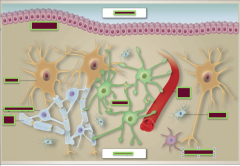
Identify: Ventricle Neuropil Ependyma Myelin sheath Oligodendrocyte Neuron Blood vessel Microglia Polydendrocyte
|
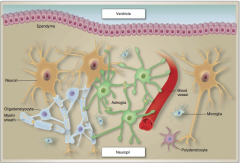
|
|
|
Where does synaptic input to a neuron primarily occur?
What are small protrusions where synaptic contacts with axons are made?
What in the spines serve as the scaffolding that holds together and organizes neurotransmitter and ion channels? |
Dendrite Spines Postsynaptic densities |
|
|
What part of the neuron makes synaptic contacts with its terminals to other neurons? |
Axon |
|
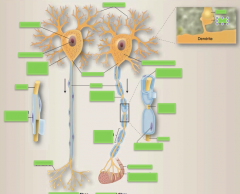
Identify |
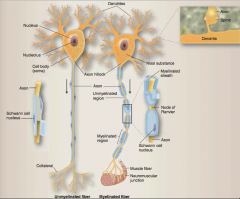
|
|
|
What part of the axon can be enwrapped by myelin and is where all input to a neuron (excitatory and inhibitory) is summed up and the decision to propagate an action potential to the next synapse is made? |
Axon hillock or initial segment |
|
|
The most abundant type of neuron in the CNS and are found in both the brain and spinal cord. Dendrites branch directly off the cell body, and a single axon arises from the axon hillock. |
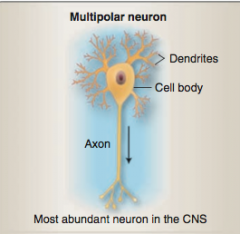
Multipolar neuron |
|
|
Found mainly in spinal ganglia. They have a dendritic axon that receives sensory information from the periphery and sends it to the spinal cord, bypassing the cell body along the way. They relay sensory information from a peripheral receptor to the CNS without modifying the signal. |
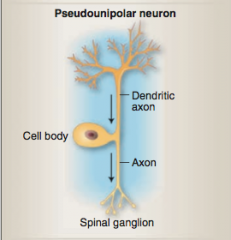
|
|
|
Found primarily in the retina and the olfactory epithelium. They have a single main dendrite that receives synaptic input, which is then conveyed to the cell body and from there via an axon to the next layer of cells
|

|
|
|
What is contact between two neuronal cells?
What is the most common type?
What is a key factor in calculating the convergence of electrical signals in time and in space? |
Synapse Axodendritic synapse => receive thousands of anxodendritic synaptic inputs => threshold => AP
Architecture of the dendritic tree (temporal summation)
|
|
|
What is the term for a synapse where axon contacts another neuron directly on the cell soma?
What is the term for when an axon contacts another axon?
Which is the more powerful of the two, producing an action potential or inhibiting action potentials what would have otherwise been fired? |
Axosomatic synapse
Axoaxonic synpase (more powerful) |
|
|
Which cells provide the myelin sheath around axons in the CNS and the PNS?
What cells are involved in ion homeostasis and nutritive functions?
What is another type of glial cell that constitutes the stem pool within the CNS with the capability of generating both new glial cells and neurons?
What are the immune cells within the brain? |
CNS = Olidogendroglia PNS = Schwann cells
Astroglia
Polydendrocytes
Microglia |
|
|
What are the components of the tripartite synapse? |
Presynaptic neuron Postsynaptic neuron Astrocyte |
|
|
What glia provide the direction and scaffolding for axon migration and targeting? |
Radial glia (a subpopulation of astrocytes) |
|
|
True or false.
One oligodendrocyte can myelinate multiple axons.
Gaps in the myelin sheath occur at regular intervals to allow the passage of ions and are called ___________. |
True
Nodes of Ranvier |
|
|
One Schwann cell can myelinate how many axons?
What can the Schwann cell do at the NMJ? |
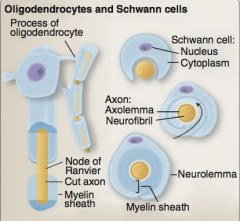
A single axon
Take up excessive neurotransmitter and maintain ion homeostasis to facilitate efficient signal transduction |
|
|
What are microglia activated by? What immune cell do they function similarly to? |
Inflammatory molecules (cytokines) Macrophages |
|
|
What can polydendrocytes regenerate?
|
Glial cells and neurons |
|
|
These epithelial cells line the ventricles and separate the cerebrospinal fluid (CSF) from the nervous tissue, or neuropil.
What is on their surface?
What produces CSF? |
Ependymal cells
Numerous cilia
Choroid plexus |
|
|
How are endothelial cells linked to each other in the CNS?
In the BBB, what contacts the vessels from the neuropil side?
What can transport across the BBB (passively)? |
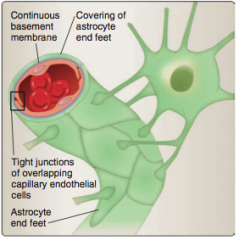
Tight junctions
Astrocyte processes
Small lipophilic molecules, water, and gas |
|
|
A neuron is surrounded by a ______membrane, which maintains differential ion concentrations on the inside versus the outside of the cell. The movement of ions across this membrane generates an _____ gradient for each ion. The sum of all ion gradients is the ______, also called the _______. It is important to note that all cells are surrounded by a phospholipid bilayer, and all cells maintain a different ion concentration on the inside versus the extracellular space. Neu- rons and muscles are, however, the only cells that are able to send signals along their surface or to harness these ion differentials to generate electrical signals. |
A neuron is surrounded by a phospholipid bilayer membrane, which maintains differential ion concentrations on the inside versus the outside of the cell. The movement of ions across this membrane generates an electrical gradient for each ion. The sum of all ion gradients is the membrane potential, also called the electrical potential. It is important to note that all cells are sur- rounded by a phospholipid bilayer, and all cells maintain a different ion concentration on the inside versus the extracellular space. Neu- rons and muscles are, however, the only cells that are able to send signals along their surface or to harness these ion differentials to generate electrical signals. |
|
|
Is K+ concentration higher inside or outside of the cell? |
Inside Moves along concentration and takes positive charge with it => potential inside cell is negative (constantly losing K+). |
|
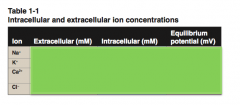
|
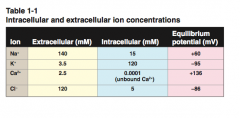
|
|
|
What is the Nerst equation?
Simplified at 37 degrees Celsius?
|
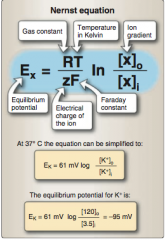
|
|
|
Define the Goldmann equation. What two things does it take into account? |
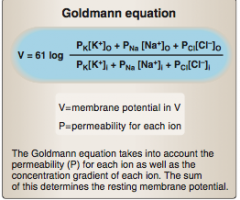
|
|
|
_____ are membrane proteins that allow ions to pass through them, which causes current flow. Ion channels are selective: The size of the _____ and the amino acids in the pore will regulate which ion can pass through. The opening or closing of ion channels is regulated by different mechanisms. |
Ion channels are membrane proteins that allow ions to pass through them, which causes current flow. Ion channels are selective: The size of the channel pore and the amino acids in the pore will regulate which ion can pass through. The opening or closing of ion channels is regulated by different mechanisms. |
|
|
Voltage-gated ion channels: These channels are regulated by the _____. A change in membrane potential opens the _____. The most prominent of these channels is the voltage-gated _____ channel. Its opening underlies the initiation of an action potential |
Voltage-gated ion channels: These channels are regulated by the membrane potential. A change in membrane potential opens the channel pore. The most prominent of these channels is the voltage-gated Na+ channel. Its opening underlies the initiation of an action potential. |
|
|
Ligand-gated ion channels: These channels are regulated by a specific ____ that binds to the ion channel. This opens the pore, and ions can pass through. Postsynaptic _____ receptors are ligand-gated ion channels |
Ligand-gated ion channels: These channels are regulated by a specific molecule that binds to the ion channel. This opens the pore, and ions can pass through. Postsynaptic neurotransmitter receptors are ligand-gated ion channels. |
|
|
Mechanically gated ion channels: The pore in these channels is _____ opened. ____ receptors in the skin and receptor cells in the _____ are examples of mechanically gated ion channels. These channels open through the mechanical deflection that pries or pulls the channel open. |
Mechanically gated ion channels: The pore in these channels is mechanically opened. Touch receptors in the skin and receptor cells in the inner ear are examples of mechanically gated ion channels. These channels open through the mechanical deflection that pries or pulls the channel open. |
|
|
Thermally gated ion channels: These channels are regulated by _____. The channel protein acts as a _____, and a change in temperature opens the channel pore. |
Thermally gated ion channels: These channels are regulated by temperature. The channel protein acts as a thermometer, and a change in temperature opens the channel pore. |
|
|
What is the underlying mechanism for APs? |
Change in membrane potential for different ions. |
|
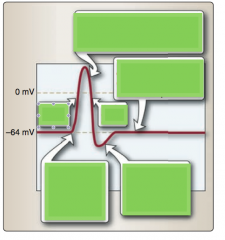
Describe what is happening at each arrow on the action potential. |
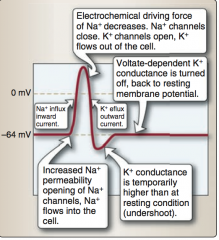
|
|
|
What describes the movement of charge or movement of ions? What is the amount of work necessary to move that charge? What is the difficulty of moving ions referred to as? What is the ease of moving ions?
|
Current Voltage Resistance Conductance |
|
|
What is the shuttling of charge (like along a wire that does NOT involve a movement of Na+ ions)?
What type of current involves the flow of Na+ through ion channels? |
Passive current
Active current |
|
|
Continuous conduction: In _____ axons, passive current flows along the axon and continuously opens ____ channels (active current) that are inserted along the entire length of the axon. Continuous _____ of APs along the entire length of axons is called continuous conduction. |
Continuous conduction: In unmyelinated axons, passive current flows along the axon and continuously opens Na+ chan- nels (active current) that are inserted along the entire length of the axon. Continuous regeneration of APs along the entire length of axons is called continuous conduction. |
|
|
Saltatory conduction: In _____ axons, Na+ channels are accumulated at the gaps in the myelin sheath (nodes of _____). Passive current is shuttled along a long segment of the myelinated axon. At the node of Ranvier, the change in mem- brane potential causes the opening of ___ channels and with that, the regeneration of the AP. The action potential seems to “jump” from node to node, which is called saltatory conduc- tion |
Saltatory conduction: In myelinated axons, Na+ channels are accumulated at the gaps in the myelin sheath (nodes of Ran- vier). Passive current is shuttled along a long segment of the myelinated axon. At the node of Ranvier, the change in mem- brane potential causes the opening of Na+ channels and with that, the regeneration of the AP. The action potential seems to “jump” from node to node, which is called saltatory conduc- tion |
|
|
Define Ohms law: |
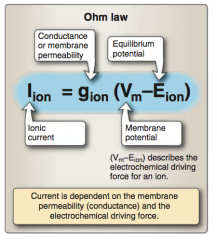
|
|
|
Describe the effect of resistance and capacitance on velocity of the action potential.
Do large or small diameter axons have higher resistance? |
Increase resistance => lower flow (small diameter = higher resistance)
Increased capacitance (repelling charge at cell membrane) => decreased flow |
|
|
What is the effect of myelin on velocity? |
Lessens the dissipation of current => increased velocity |
|
|
What does the velocity of active current depend on?
How can you reduce capacitance?
|
Capacitance of the membrane
Reduction in ion diameter => decreased surface area
or
Myelination of the axon (but you can't be permeable to ions now so that's why you have Nodes of Ranvier). |
|
|
Two types of synapses? |
Electrical and chemical |
|
|
What are two neurons coupled electrically to each other via?
What is this structure composed of?
Where are electrical gap junctions found? |
Gap junctions
Six connexins => connexon Two connexons => gap junction
Breathing center and in hormone-secreting regions of hypothalamus |
|
|
What are the three components of a chemical synapse?
How is communication achieved? |
Pre-synaptic terminal, synaptic cleft, and a post-synaptic terminal
Via neurotransmitters |
|
|
What does an influx of Na+ cause in the PSP? Influx of Cl-? |
Na+ = EPSP => moves membrane potential closer to threshold Cl- = IPSP => moves membrane potential away from threshold |
|
|
Only the cumulative effect of thousands of synapses on a postsynaptic neuron will lead to an AP. What is this called? |
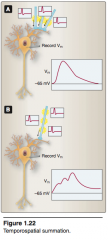
Temporospatial summation |
|
|
What are the five steps of chemical synapse? |
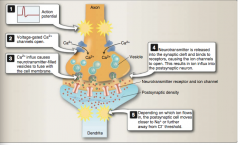
|
|
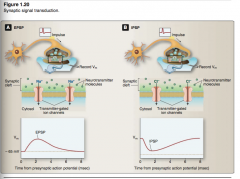
|
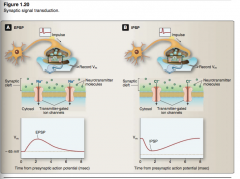
|
|
|
What is an ionotropic receptor? |
Neurotransmitter coupled with an ion channel Neurotransmitter binds to receptor => conformational change allows ions to flow through the channel. |
|
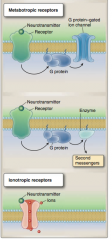
What is a metabotropic receptor? |
Neurotransmitter coupled with intracellular signaling cascades (often a G-protein coupled receptor often involving enzymes). |
|
|
What is the most common excitatory neurotransmitter? What can it bind to?
What do all of these receptors cause? |
Glutamate NMDA, AMPA, and kainate receptors
Influx of cations into postsynaptic neurons NMDA receptor is blocked by Mg2+ unless postsynaptic membrane is depolarized |
|
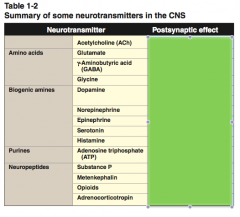
|
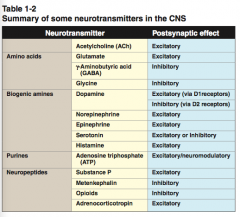
|
|
|
What is glutamate synthesized from and what supplies it? |
Glutamine (astrocytes from glutamate they take up in synaptic clefts) |
|
|
What are the two most important inhibitory neurotransmitters? |
GABA and glycine |
|
|
What does glycine bind to? What does GABA bind to? |
Ionotropic receptor => Cl- influx
GABAa and GABAc => Cl- influx (inhibition) GABAb => activates K+ channels, blocks Ca2+ channels => net loss of positive charge (hyper polarization and inhibition) |
|
|
What is the neurotransmitter used at the neuromuscular junction?
What are the two receptor types?
Is there an uptake mechanism? |
Acetylcholine
Nicotinic => ionotropic Muscarinic => metabotropic
No, broken down via acetylcholinesterase |
|
|
_____ is involved in many forebrain circuits associated with emotion, motivation, and reward. It acts on G protein–coupled receptors, and its action can be either excitatory (via D_ receptors) or inhibitory (via D_ receptors). |
Dopamine D1 = excitatory D2 = inhibitory |
|
|
Key neurotransmitter involved in wakefulness and attention. It acts on the metabotropic α-adrenergic and β-adrenergic receptors, both of which are excitatory |
Norepinephrine |
|
|
Acts on the same receptors, but its con- centration in the CNS is much lower than that of norepinephrine. |
Epinephrine |
|
|
Binds to an excitatory metabotropic receptor. In the CNS, it is involved in wakefulness |
Histamine |
|
|
Both excitatory and inhibitory effects. It is involved in a multitude of pathways that regulate mood, emotion, and several homeostatic pathways. Most ______ receptors are metabotropic. There is only one ionotropic receptor, which is a nonselective cation channel and is, therefore, excitatory. |
Serotonin |
|
|
ATP: ATP is best known as the ______ within cells. However, it is also released by presynaptic neurons as a ______. Because it is often released together with other neurotransmitters, it is referred to as a _____. ATP can be broken down in the synaptic cleft to adenosine, a ____, which binds and activates the same receptors as ATP. These purinergic receptors can be either ionotropic (P2___) or metabotropic (P2___). The ionotropic receptors are coupled with nonspecific cation channels and are _____. The metabotropic receptors act on G protein–coupled signaling pathways. ATP and purines are _____. Because they are co- released with other neurotransmitters, the degree of P2X or P2Y activation will modulate the response to the other neurotransmitter secreted, either enhancing that action or inhibiting it. |
ATP: ATP is best known as the energy carrier within cells.2 However, it is also released by presynaptic neurons as a neu- rotransmitter. Because it is often released together with other neu- rotransmitters, it is referred to as a cotransmitter. ATP can be broken down in the synaptic cleft to adenosine, a purine, which binds and activates the same receptors as ATP. These purinergic receptors can be either ionotropic (P2X) or metabotropic (P2Y). The ionotropic receptors are coupled with nonspecific cation channels and are excitatory. The metabotropic receptors act on G protein–coupled signaling pathways. ATP and purines are neuromodulators. Because they are co- released with other neurotransmitters, the degree of P2X or P2Y activation will modulate the response to the other neurotransmitter secreted, either enhancing that action or inhibiting it. |
|

|

|

